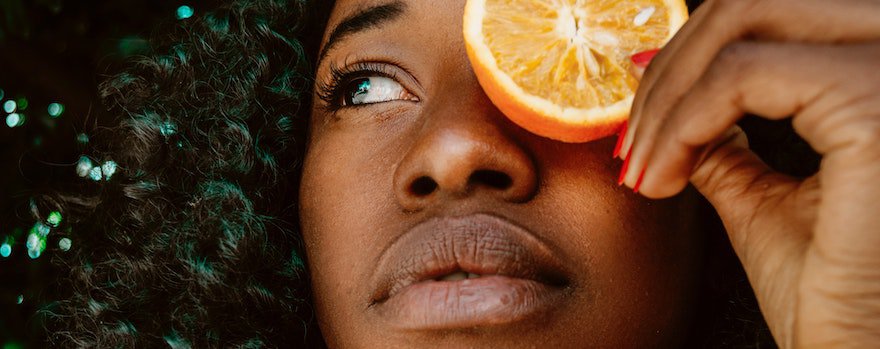Collagen is a protein majeure qui assure le maintenance of our tissues. It is present in a few foods: bones, meat cartilage, skin and fish bones, for example.
Other foods provide our body the nutrients that support collagen production. This is the case, for example, with vitamin C and amino acids such as proline and lysine or glycine found in collagen protein.
Here are 5 foods to prioritize to boost collagen production! Find out everything about collagen after the list.
Also read | Best marine collagen: our tips for choosing the right one
1. Gelatin

Gelatin is obtained from boiled animal skin and bones. Rich in protein, it notably contains the amino acids proline, glycine and lysine, which enable collagen synthesis. This preliminary study on collagen extracted from chicken cartilage showed an effect on short-term collagen synthesis.
How to consume it : gelatin is available in powder or sheets. It can be used to make panna cotta or aspic eggs, for example. You can also make a homemade broth with quality cuts like marrow bones or cartilaginous poultry parts.
2. Turkey

Turkey is a white meat particularly rich in protein and amino acids, notably glycine. This study in vitro shows the key role of glycine in collagen synthesis. It is also a good source of zinc, a trace element that supports protein synthesis.
How to consume it : prefer turkey breasts, which are leaner and contain slightly more protein than thighs or drumsticks. Choose organic or Label Rouge meat if possible. You can cook it with a curry and coconut milk sauce or a homemade chili paste. Or thinly slice and pan-fry it with seasonal vegetables.
3. Cod

Salted cod is simply cod that has been salted! It is a cold-water fish that lives mainly in the Atlantic. Cod is a very good source of lysine. It is an amino acid that plays an important role in the formation of collagen fibers.
How to consume it : you can prepare it as brandade with potatoes and a persillade. Or draw from the repertoire of Portuguese cuisine by making a stew with potatoes, tomatoes, peppers, and carrots.
4. Royal jelly

The royal jelly is a whitish liquid produced by bees to feed the queen and the larvae. It is rich in antioxidants in the form of amino acids. It helps to stimulate collagen production. A study conducted on rats showed its effectiveness on collagen production.
How to consume it: fresh royal jelly is particularly rich in nutrients. You can find it from a beekeeper or in an organic shop. Royal jelly is also available as capsules, tablets, or vials.
Also read Royal jelly: our buying guide
5. Camu camu

The camu camu is a small fruit native to the Amazon. It belongs to the same family as the guava. It is a fruit extremely high in vitamin C. It contains nearly 20 times more than a kiwi! Vitamin C plays a key role in collagen synthesis, as highlighted by this article.
How to consume it: prefer organic camu-camu. Its taste is bitter. It’s generally available as a powder that can be mixed into a juice, a smoothie, a compote, or porridge. You can also add it to a citrus cheesecake or a carrot cake.
Collagen, the structural protein of our body
What is collagen?
The term collagen comes from the Greek kólla which means glue. Some ancient peoples used animal collagen to make one of the very first forms of glue.
Collagen is the most abundant protein in our body. It is found especially in the bones, skin, muscles, cartilage, ligaments and tendons. Our tendons, which are heavily used during movement, are almost exclusively made of it! Collagen also gives the skin its suppleness and elasticity.
We synthesize this protein throughout our lives but in decreasing amounts. It is therefore natural that our skin will loosen and sag as we age. The cartilage in our joints can also deteriorate.
Our lifestyle habits, such as tobacco or alcohol consumption, can impact collagen production. So can overexposure to UV rays and pollution.
Also read 16 foods and supplements that are good for the skin
How to promote collagen production?

Like all other proteins, collagen is made up of a chain of amino acids. Proline, glycine and lysine are among the most important. A sufficient intake of these amino acids supports its production. Gelatin contains these three amino acids.
Vitamin C is crucial in the synthesis of collagen, as highlighted by this article. It plays a supporting role for two enzymes that accelerate its production. Camu camu and acerola are very good sources.
Referred to by some as the fountain-of-youth protein, it also exists as a dietary supplement. It is often found as hydrolyzed collagen, meaning the molecule has been partially broken down. Questions surrounding the absorption and bioavailability of the different forms of collagen continue to be researched. As a reminder, the bioavailability of a nutrient refers to the portion that is absorbed and effectively used by the body.
Also read Our tips to promote collagen production naturally
A closer look at marine collagen
A good alternative
Like other species, fish also contain collagen. It is notably found in their skin and bones. It is mainly consumed in the form of a dietary supplement (collagen peptides).
Marine collagen is an alternative to bovine- or porcine-derived collagen for people on restrictive diets.
Several studies have been conducted on marine collagen. This one, for example, looks at the use of salmon collagen to regenerate bone tissue. This other study conducted on mice suggests the potential antioxidant role of marine collagen peptides.
Choosing the right marine collagen
The fishing industry produces significant waste from fish processing (skins, bones, etc.). Producing marine collagen from these materials can be a way to add value to them. It is, of course, necessary to implement processes that guarantee the quality of these materials.
When buying marine collagen, we recommend paying attention to the origin of the products. It can be reassuring to be able to consult certificates indicating the absence of heavy metals.
The sustainability of the aquaculture and fishing methods used is also a factor to consider. As is certification of being GMO-free.



